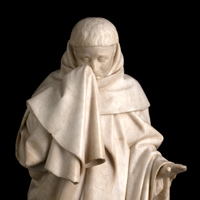Unique Medieval Studies class sheds light on DMA exhibit
Students fill a weekly class centered on medieval alabaster sculptures that once adorned the tomb of John the Fearless.

Nancy George
SMU News
Ninety SMU students pack the front rows of the Dallas Museum of Art’s auditorium each Thursday afternoon for a three-hour class that draws upon a unique museum exhibit.
“The Mourners: Medieval Tomb Sculptures from the Court of Burgundy” features 40 medieval masterpieces, alabaster sculptures commissioned for the elaborate tomb of John the Fearless, the second duke of Burgundy, France. The sculptures, never exhibited outside of Dijon, France, are midway through a seven-city U.S. tour while their exhibit space at Dijon’s Musee des Beaux Arts undergoes renovation.
SMU Medieval Studies professors Bonnie Wheeler and Jeremy Adams seized the opportunity to create a one-time class based on the exhibit and its insight into medieval history, politics, literature, ceremony and religion. They collaborated with Rick Brettell, Margaret McDermott Distinguished Chair of Art and Aesthetics, University of Texas at Dallas, to teach the class along with guest lecturers from universities throughout the country.
Forty UTD students attend the class along with a growing number of visitors. Museum members and paying visitors also may visit the class that meets Thursday afternoons from 3 to 6 p.m. in the Horchow Auditorium.
“The class is almost like a puzzle,” says Rachel Allen, senior art history and Spanish major and Medieval Studies minor. “Each week we receive a new piece and it is our job to assemble a complete image of the Mourners in medieval France as the class progresses. The visiting faculty members are prestigious scholars in their fields and have encouraged the students to ask questions. I feel like a kid in a candy store.”
A class of this scope is unprecedented for the Dallas Museum of Art, says Lisa Kays, DMA manager of adult programming.
The court of Burgundy was the most brilliant manifestation of late medieval Europe, says Bonnie Wheeler, associate professor of English and director of medieval studies.
“During the 15th century, when these masterful tomb figures were made, the court oversaw the creation of the Order of the Golden Fleece on the one hand, and, on the other, the system of banking and finance that linked northern and southern Europe more powerfully than ever before. In addition, the ducal family were patrons of the most important manuscripts and tapestries created in medieval Europe.”
The once-in-a lifetime exhibit will return to Dijon in 2012, and its one-time SMU and UTD class will wrap up in December. But students and faculty have no regrets.
“Life is short, memory is long,” Wheeler says.
Related Links:
- "Majesty, Memory and Mourning in the Late Middle Ages" class website
- About the French Regional & American Museum Exchange
- More about "The Mourners" at the Dallas Museum of Art
- Tour Schedule for "The Mourners"
- The Dallas Museum of Art
- The SMU Medieval Studies Program
# # #